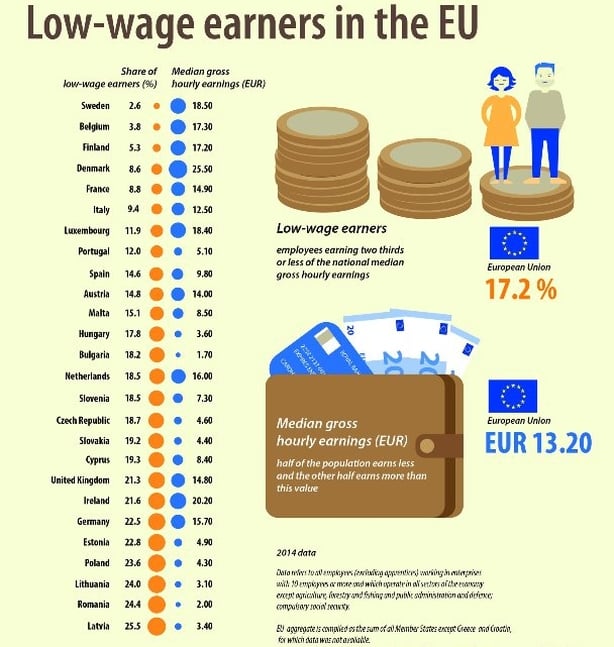Ireland is among the countries with the highest proportion of low-wage workers in the EU, according to Eurostat, with just over one in five workers here falling into the low-wage category.
But Ireland also has the second highest median gross hourly earnings, at just over €20 an hour – almost 12 times the average hourly earnings in lowest-placed Bulgaria, where median earnings are €1.70 an hour.
Low wage is defined as two thirds or less of the national median gross hourly earnings.
For the EU as a whole, low wage earners make up 17.2% of employees.
Latvia is the EU state with the highest proportion of low wage earners, with 25.5% falling into this category, followed by Romania (24.4%), Lithuania (24%), and Poland (23.6%).
Ireland comes in at seventh highest of the 28 states with a low wage share of 21.6% - falling in between Germany (22.5%) and the UK (21.3%).
By contrast, the low-wage earners were less than 10% of employees in just six states - Sweden (2.6%), Belgium (3.8%), Finland (5.3%), Denmark (8.6%), France (8.8%), and Italy (9.4%).
Across member states, the highest national median gross hourly earnings was five times higher than the lowest when expressed in Purchasing Power Standards (PPS), which eliminates price level differences between countries.

As measured in October 2014, the highest median gross hourly earnings in PPS were recorded in Denmark (18.5 PPS) and Ireland (18.4 PPS), ahead of Belgium (15.4 PPS), Germany and Luxembourg (both 15.0 PPS), the Netherlands and Sweden (both 14.5 PPS).
At the opposite end of the scale, the lowest median gross hourly earnings in PPS were registered in Bulgaria (3.6 PPS) and Romania (4.0 PPS), followed by Latvia (5.0 PPS) and Lithuania (5.1 PPS).
Differences between member states are even more pronounced when median gross hourly earnings are expressed in euro.
The highest median gross hourly earnings in euro were recorded in Denmark (€25.5), ahead of Ireland (€20.2), Sweden (€18.5), Luxembourg (€18.4), Belgium (€17.3) and Finland (€17.2).
In contrast, the lowest median gross hourly earnings in euro were registered in Bulgaria (€1.7) and Romania (€2.0), followed by Lithuania (€3.1), Latvia (€3.4) and Hungary (€3.6).
In other words, across member states, the highest national median gross hourly earnings were 15 times higher than the lowest when expressed in euro.
There are large differences between genders and age groups regarding the proportion of low-wage earners.
In the EU in 2014, 21.1% of female employees were low-wage earners, compared with 13.5% of male employees.
Moreover, almost a third (30.1%) of employees aged less than 30 were low wage earners, compared with 14% or less for age groups between 30 and 59.
The level of education also plays an important role: the lower the level, the higher is the likelihood of being a low-wage earner.
In the EU in 2014, while 28.2% of employees with a low education level were low-wage earners, the proportion decreased to 20.9% for those with a medium education level and to less than 7% (6.4%) for employees with a high education level.
The type of contract also has a significant impact.
In the EU in 2014, 31.9% of employees with a contract of limited duration were low-wage earners, compared with 15.3% of those with an indefinite contract.

